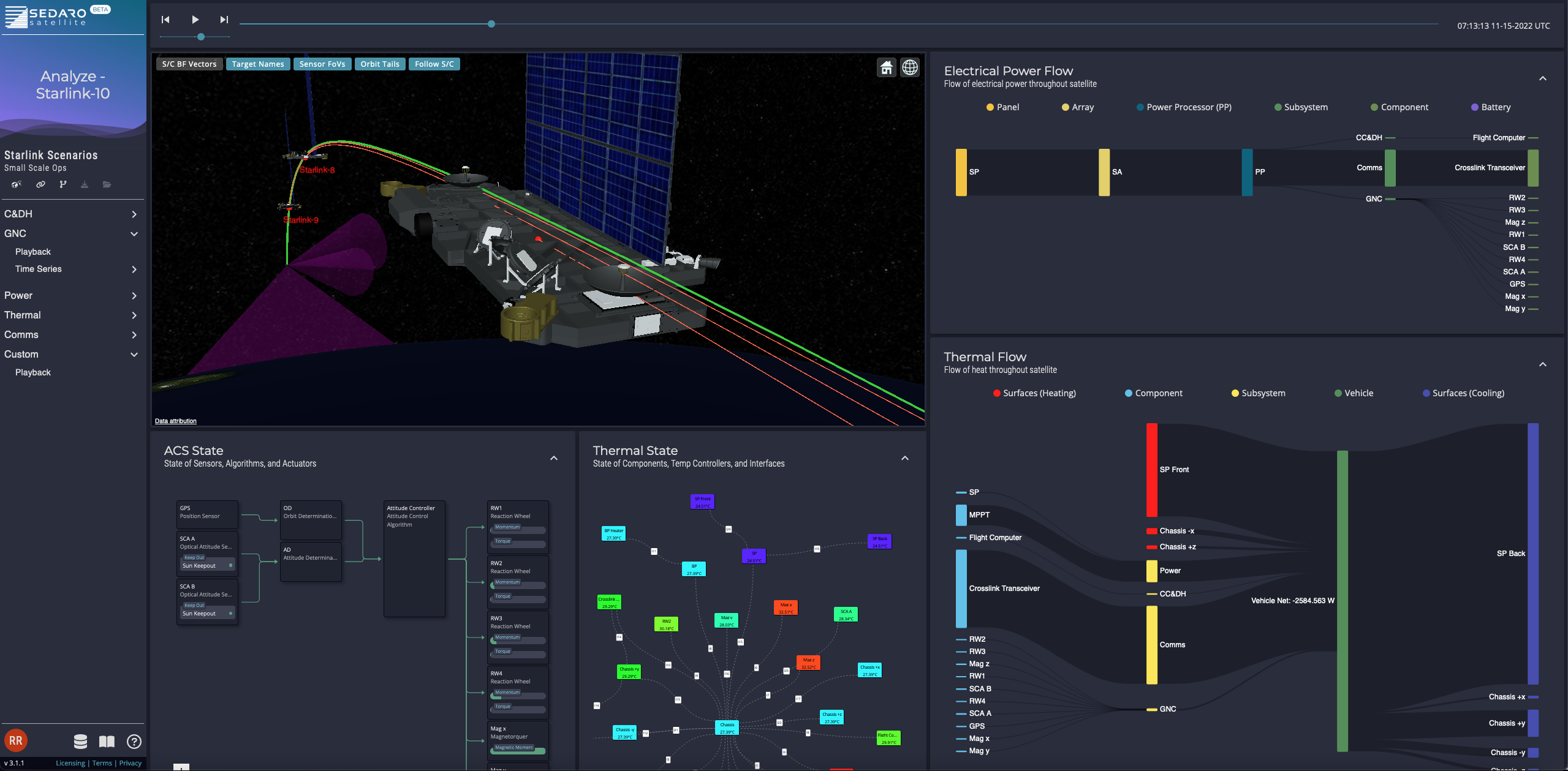Introduction
Sedaro
Sedaro is a cloud-native platform for space system digital twins: exceptionally interoperable and high-fidelity virtual representations of the physical systems that your missions depend on. Today’s space systems are complex, dynamic, and distributed. Accordingly, Sedaro is built to handle complex interactions throughout your ConOps, with digital twins that dynamically evolve alongside your mission and with a distributed architecture that allows for fast and efficient modeling of constellations and other distributed space systems.

Simulation of a Starlink Constellation in Sedaro
A multi-disciplinary approach allows Sedaro to thrive where existing tools fall short. Spacecraft systems (e.g., thermal, electrical power, control, etc.) are highly interdependent, but existing Modeling, Simulation, and Analysis (MS&A) tools for discipline-specific simulations are not readily integrated with one another. Often the resulting efforts are serial and manual, a costly solution that results in delays and leaves regions of trade space unexplored.
Sedaro provides a seamless combination of multi-disciplinary MS&A, allowing for more efficient iteration and ultimately better designs. Sedaro also serves as a platform for you to integrate custom MS&A tools one piece at a time, giving the user flexible control of the simulation that changes as the design progresses.
True space system digital twins are only possible using a parallel and distributed approach. Sedaro optimally distributes the workload for simulating a digital twin across an adaptive simulation bed – a network of compute nodes and data exchange hubs that enables execution times nearly independent of simulation complexity. This scalability makes Sedaro a powerful tool that scales in complexity throughout the lifecycle of your mission.
- Concept Design - Mission templates and library imports combined with cloud compute resources allow you to rapidly explore trade space.
- Detailed Design - Git-style version control and shareable links drive collaboration across your team and allow you to rapidly iterate and test your prototypes. Integrate your own MS&A tools, customizing the Sedaro platform to suit your needs.
- Integration & Testing - Integration with process management software supports streamlined verification and informed decision making. Incorporate hardware, software, and humans-in-the-loop for robust testing.
- Operations - Your digital twin can be leveraged to test commands and software updates, create collaborative operator training tools, and diagnose and respond to on-orbit faults.
Get started now, and see what Sedaro can do for your mission at https://satellite.sedaro.com.
Clients
Sedaro provides a comprehensive design environment within our web client. Our services can also be consumed from a multitude of programming languages, including Python, R, MATLAB, JavaScript, and Java by using our OpenAPI clients. Examples of modeling and simulation capabilities beyond what is achievable in the web client can be found in our ModSim Jupyter Notebooks.
Structure
At the highest level, Sedaro allows you to design Agents and Scenarios. Agents are digital twin templates with subsystems (Power, Thermal, GNC, etc.) that are designed down to the component level. Scenarios are missions that incorporate your digital twins and other Peripheral Agents into a full ConOps. Once you design and simulate a scenario, you can review analytics at the full Scenario and individual Agent level. Both Agents and Scenarios utilize Git-style version control for efficient design iteration.
Going deeper, Agents are composed of blocks, which are passively created as you design your spacecraft in the UI. You can also add, edit, and delete these blocks directly using any of our API clients. Blocks are directly handled in our simulation bed with the use of State Managers. State Managers update state variables of blocks as the simulation progresses; for example, the state of charge of the battery is updated based on the amount of current flowing in/out at the current time. Sedaro natively uses the State Managers written by our Modeling and Simulation team, but customers will eventually be able to plug in custom State Managers, allowing them to customize our platform to best suit their needs.
Account
For account administration, please visit the Management Console.
Pricing
With an annual SaaS license, your company will be able to sign up as many individuals as they would like within the organization. The only consideration between license tiers is compute capacity.
Additionally, dedicated, managed instances of Sedaro are available in AWS, Azure, or on-premise clouds. We also offer flexible contractual relationships to support your business model or application including royalties and perpetual licenses.
For more information, please contact sales@sedarotech.com.